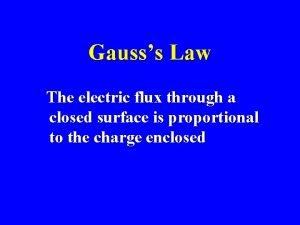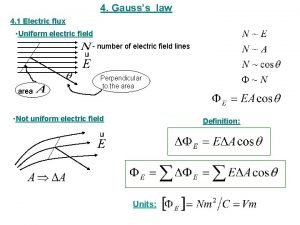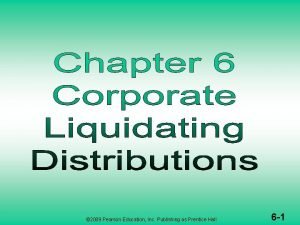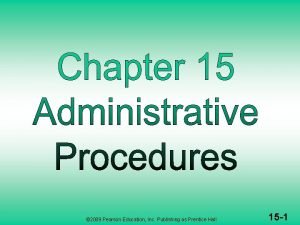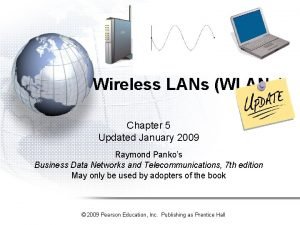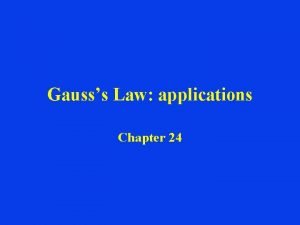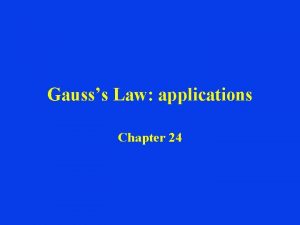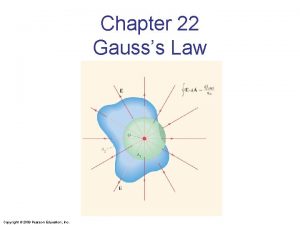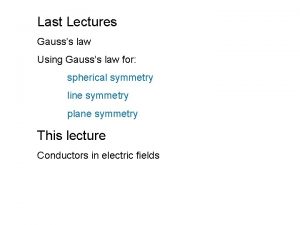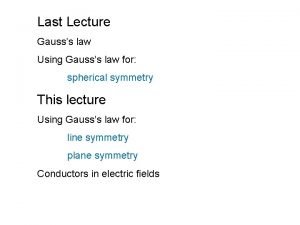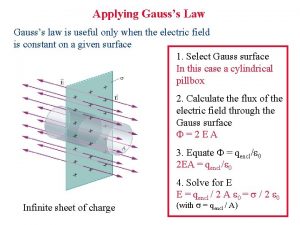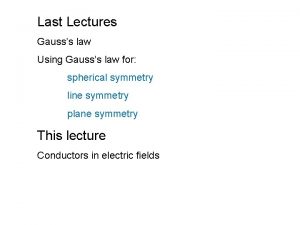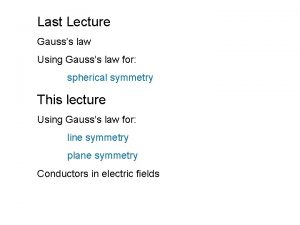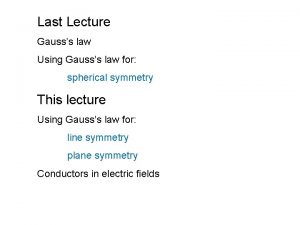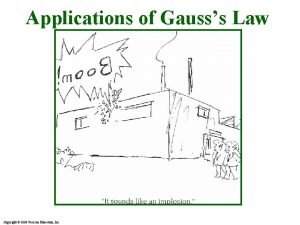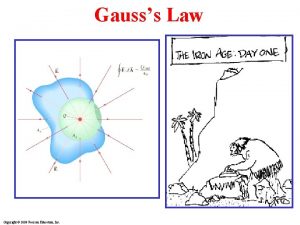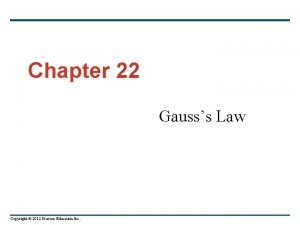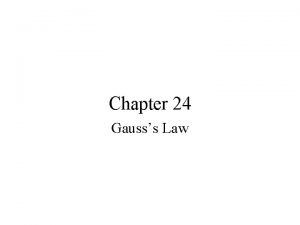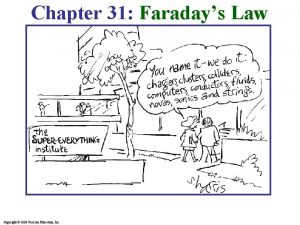Chapter 22 Gausss Law Copyright 2009 Pearson Education


















































- Slides: 50

Chapter 22 Gauss’s Law Copyright © 2009 Pearson Education, Inc.

22 -3 Applications of Gauss’s Law Conceptual Example 22 -9: Conductor with charge inside a cavity. Suppose a conductor carries a net charge +Q and contains a cavity, inside of which resides a point charge +q. What can you say about the charges on the inner and outer surfaces of the conductor? Copyright © 2009 Pearson Education, Inc.

22 -3 Applications of Gauss’s Law Procedure for Gauss’s law problems: 1. Identify the symmetry, and choose a gaussian surface that takes advantage of it (with surfaces along surfaces of constant field). 2. Draw the surface. 3. Use the symmetry to find the direction of E. 4. Evaluate the flux by integrating. 5. Calculate the enclosed charge. 6. Solve for the field. Copyright © 2009 Pearson Education, Inc.

22 -4 Experimental Basis of Gauss’s and Coulomb’s Laws In the experiment shown, Gauss’s law predicts that the charge on the ball flows onto the surface of the cylinder when they are in contact. This can be tested by measuring the charge on the ball after it is removed – it should be zero. Copyright © 2009 Pearson Education, Inc.

Summary of Chapter 22 • Electric flux: • Gauss’s law can be used to calculate the field in situations with a high degree of symmetry. • Gauss’s law applies in all situations. • Follows from Coulomb’s Law Copyright © 2009 Pearson Education, Inc.

Chapter 23 Electric Potential Copyright © 2009 Pearson Education, Inc.

Units of Chapter 23 • Electric Potential Energy and Potential Difference • Relation between Electric Potential and Electric Field • Electric Potential Due to Point Charges • Potential Due to Any Charge Distribution • Equipotential Surfaces • Electric Dipole Potential Copyright © 2009 Pearson Education, Inc.

Units of Chapter 23 • E Determined from V • Electrostatic Potential Energy; the Electron Volt Copyright © 2009 Pearson Education, Inc.

23 -1 Electrostatic Potential Energy and Potential Difference The electrostatic force is conservative – potential energy can be defined. Change in electric potential energy is negative of work done by electric force: Copyright © 2009 Pearson Education, Inc.

Concep. Test 23. 1 Electric Potential Energy A proton and an electron are in a constant electric field created by oppositely charged plates. You release the proton from the positive side and the electron from the negative side. Which has the larger acceleration? 1) proton 2) electron 3) both feel the same acceleration 4) neither – there is no acceleration 5) they feel the same magnitude acceleration but opposite direction Electron electron - + Proton proton

Concep. Test 23. 1 Electric Potential Energy A proton and an electron are in a constant electric field created by oppositely charged plates. You release the proton from the positive side and the electron from the negative side. Which has the larger acceleration? 1) proton 2) electron 3) both feel the same acceleration 4) neither – there is no acceleration 5) they feel the same magnitude acceleration but opposite direction Since F = ma and the electron is much less Electron electron - massive than the proton, the electron experiences the larger acceleration + Proton proton

23 -1 Electrostatic Potential Energy and Potential Difference Electric potential is defined as potential energy per unit charge: Unit of electric potential: the volt (V): 1 V = 1 J/C. Copyright © 2009 Pearson Education, Inc.

23 -1 Electrostatic Potential Energy and Potential Difference Only changes in potential can be measured, allowing free assignment of V = 0: Sound like gravity? Copyright © 2009 Pearson Education, Inc.

23 -1 Electrostatic Potential Energy and Potential Difference Analogy between gravitational and electrical potential energy: Copyright © 2009 Pearson Education, Inc.

23 -1 Electrostatic Potential Energy and Potential Difference Conceptual Example 23 -1: A negative charge. Suppose a negative charge, such as an electron, is placed near the negative plate at point b, as shown here. If the electron is free to move, will its electric potential energy increase or decrease? How will the electric potential change? Copyright © 2009 Pearson Education, Inc.

23 -1 Electrostatic Potential Energy and Potential Difference Electrical sources such as batteries and generators supply a constant potential difference. Here are some typical potential differences, both natural and manufactured: Copyright © 2009 Pearson Education, Inc.

Concep. Test 23. 2 Work and Potential Energy Which group of charges took more work to bring together from a very large initial distance apart? +2 d +1 +1 d +1 Both took the same amount of work. d d +1

Concep. Test 23. 2 Work and Potential Energy Which group of charges took more work to bring together from a very large initial distance apart? +2 d +1 +1 Both took the same amount of work. The work needed to assemble a collection of charges is the same as the total PE of those charges: added over all pairs d d +1 For case 1: only 1 pair For case 2: there are 3 pairs

23 -2 Relation between Electric Potential and Electric Field The general relationship between a conservative force and potential energy: Substituting the potential difference and the electric field: Copyright © 2009 Pearson Education, Inc.

23 -2 Relation between Electric Potential and Electric Field The simplest case is a uniform field: Copyright © 2009 Pearson Education, Inc.

23 -2 Relation between Electric Potential and Electric Field Example 23 -3: Electric field obtained from voltage. Two parallel plates are charged to produce a potential difference of 50 V. If the separation between the plates is 0. 050 m, calculate the magnitude of the electric field in the space between the plates. Copyright © 2009 Pearson Education, Inc.

23 -2 Relation between Electric Potential and Electric Field Example 23 -4: Charged conducting sphere. Determine the potential at a distance r from the center of a uniformly charged conducting sphere of radius r 0 for (a) r > r 0, (b) r = r 0, (c) r < r 0. The total charge on the sphere is Q. Copyright © 2009 Pearson Education, Inc.

23 -2 Relation between Electric Potential and Electric Field The previous example gives the electric potential as a function of distance from the surface of a charged conducting sphere, which is plotted here, and compared with the electric field: Copyright © 2009 Pearson Education, Inc.

23 -3 Electric Potential Due to Point Charges To find the electric potential due to a point charge, we integrate the field along a field line: Copyright © 2009 Pearson Education, Inc.

23 -3 Electric Potential Due to Point Charges Setting the potential to zero at r = ∞ gives the general form of the potential due to a point charge: Copyright © 2009 Pearson Education, Inc.

23 -3 Electric Potential Due to Point Charges Example: Work required to bring two positive charges close together. What minimum work must be done by an external force to bring a proton q = 1. 60× 10 -19 C from a great distance away (take r = ∞) to a point 1. 60× 10 -15 m from another proton? Copyright © 2009 Pearson Education, Inc.

23 -3 Electric Potential Due to Point Charges Example: Work required to bring two positive charges close together. What minimum work must be done by an external force to bring a proton q = 1. 60× 10 -19 C from a great distance away (take r = ∞) to a point 1. 60× 10 -15 m from another proton? Wext = ke 2/r - ke 2/ = (9× 109) (1. 6× 10 -19)2/ (1× 10 -15) = 2. 3× 10 -13 J Copyright © 2009 Pearson Education, Inc.

23 -8 Electrostatic Potential Energy; the Electron Volt The potential energy of a charge in an electric potential is U = q. V. To find the electric potential energy of two charges, imagine bringing each in from infinitely far away. The first one takes no work, as there is no field. To bring in the second one, we must do work due to the field of the first one; this means the potential energy of the pair is: Copyright © 2009 Pearson Education, Inc.

23 -8 Electrostatic Potential Energy; the Electron Volt One electron volt (e. V) is the energy gained by an electron moving through a potential difference of one volt: 1 e. V = 1. 6 × 10 -19 J. The electron volt is often a much more convenient unit than the joule for measuring the energy of individual particles. Copyright © 2009 Pearson Education, Inc.

Back to the two protons Wext = ke 2/r - ke 2/ = (9× 109) (1. 6× 10 -19)2/ (1× 10 -15) = 2. 3× 10 -13 J/(1. 6× 10 -19 J/e. V) = 1. 4× 106 e. V = 1. 4 Me. V me. V/e. V convenient for Atomic/Molecular Physics Me. V/Ge. V convenient for Nuclear Physics Ge. V/Te. V convenient of High Energy Physics o A = Angstrom = 10 -10 m for AMO Physics & Chem fm = Fermi = femtometer = 10 -15 m for NP & HEP Copyright © 2009 Pearson Education, Inc.

Concep. Test 23. 3 Electric Potential 1) V > 0 What is the electric potential at point B? 2) V = 0 3) V < 0 A B

Concep. Test 23. 3 Electric Potential 1) V > 0 What is the electric potential at point B? 2) V = 0 3) V < 0 Since Q 2 and Q 1 are equidistant from point B, and since they have equal and opposite charges, the total potential is zero Follow-up: What is the potential at the origin of the x y axes? A B

23 -3 Electric Potential Due to Point Charges Example 23 -7: Potential above two charges. Calculate the electric potential (a) at point A in the figure due to the two charges shown. Copyright © 2009 Pearson Education, Inc.

23 -4 Potential Due to Any Charge Distribution The potential due to an arbitrary charge distribution can be expressed as a sum or integral (if the distribution is continuous): or Copyright © 2009 Pearson Education, Inc.

23 -4 Potential Due to Any Charge Distribution Example 23 -8: Potential due to a ring of charge. A thin circular ring of radius R has a uniformly distributed charge Q. Determine the electric potential at a point P on the axis of the ring a distance x from its center. Copyright © 2009 Pearson Education, Inc.

23 -4 Potential Due to Any Charge Distribution Example 23 -9: Potential due to a charged disk. A thin flat disk, of radius R 0, has a uniformly distributed charge Q. Determine the potential at a point P on the axis of the disk, a distance x from its center. Copyright © 2009 Pearson Education, Inc.

Concep. Test 23. 5 Equipotential Surfaces Which of these configurations gives V = 0 at all points on the x axis? +2 m. C +1 m. C x -2 m. C -1 m. C 1) +2 m. C -2 m. C x -1 m. C 4) all of the above -2 m. C 2) x +1 m. C -1 m. C 3) 5) none of the above

Concep. Test 23. 5 Equipotential Surfaces Which of these configurations gives V = 0 at all points on the x axis? +2 m. C +1 m. C x -2 m. C -1 m. C 1) +2 m. C -2 m. C x -1 m. C 4) all of the above -2 m. C 2) x +1 m. C -1 m. C 3) 5) none of the above Only in case (1), where opposite charges lie directly across the x axis from each other, do the potentials from the two charges above the x axis cancel the ones below the x axis.

23 -5 Equipotential Surfaces An equipotential is a line or surface over which the potential is constant. Electric field lines are perpendicular to equipotentials. The surface of a conductor is an equipotential (E// =0 → ∂V/∂s// = 0) Copyright © 2009 Pearson Education, Inc.

23 -5 Equipotential Surfaces Equipotential surfaces are always perpendicular to field lines; they are always closed surfaces (unlike field lines, which begin and end on charges). Copyright © 2009 Pearson Education, Inc.

23 -5 Equipotential Surfaces A gravitational analogy to equipotential surfaces is the topographical map – the lines connect points of equal gravitational potential (altitude). Copyright © 2009 Pearson Education, Inc.

23 -6 Electric Dipole Potential The potential due to an electric dipole is just the sum of the potentials due to each charge, and can be calculated exactly. For distances large compared to the charge separation: Copyright © 2009 Pearson Education, Inc.

23 -7 E Determined from V If we know the field, we can determine the potential by integrating. Inverting this process, if we know the potential, we can find the field by differentiating: This is a vector differential equation; here it is in component form: Copyright © 2009 Pearson Education, Inc.

23 -7 E Determined from V Example 23 -11: E for ring and disk. Use electric potential to determine the electric field at point P on the axis of (a) a circular ring of charge and (b) a uniformly charged disk. Copyright © 2009 Pearson Education, Inc.

Copyright © 2009 Pearson Education, Inc.

Concep. Test 23. 7 Work and Electric Potential 1) P 1 Which requires the most work, to move a positive charge from P to points 1, 2, 3 or 4 ? All points are the same distance from P. 2) P 2 3) P 3 4) P 4 5) all require the same amount of work 3 2 1 P 4

Concep. Test 23. 7 Work and Electric Potential Which requires the most work, to move a positive charge from P to points 1, 2, 3 or 4 ? All points are the same distance from P. For path #1, #1 you have to push the positive charge against the E field, which is hard to do. do By contrast, path #4 is the easiest, since the field does all the work. 1) P 1 2) P 2 3) P 3 4) P 4 5) all require the same amount of work 3 2 1 P 4

Summary of Chapter 23 • Electric potential is potential energy per unit charge: • Potential difference between two points: • Potential of a point charge: Copyright © 2009 Pearson Education, Inc.

Summary of Chapter 23 • Equipotential: line or surface along which potential is the same. • Electric dipole potential is proportional to 1/r 2. • To find the field from the potential: Copyright © 2009 Pearson Education, Inc.

Questions? Copyright © 2009 Pearson Education, Inc.
 Copyright 2009
Copyright 2009 Copyright 2009 pearson education inc
Copyright 2009 pearson education inc Copyright 2009 pearson education inc
Copyright 2009 pearson education inc 2009 pearson education inc
2009 pearson education inc 2009 pearson education inc
2009 pearson education inc 2009 pearson education inc
2009 pearson education inc Gausss law
Gausss law Flux
Flux 2009 pearson education inc
2009 pearson education inc 2009 pearson education inc
2009 pearson education inc 2009 pearson education inc
2009 pearson education inc Pearson education 2009
Pearson education 2009 2009 pearson education inc
2009 pearson education inc 2009 pearson education inc
2009 pearson education inc Pearson education ltd
Pearson education ltd 2017 pearson education inc
2017 pearson education inc Copyright 2010 pearson education inc
Copyright 2010 pearson education inc 2018 pearson education inc
2018 pearson education inc Copyright 2014 pearson education inc
Copyright 2014 pearson education inc Copyright 2010 pearson education inc
Copyright 2010 pearson education inc Copyright 2010 pearson education inc
Copyright 2010 pearson education inc Copyright by pearson education inc. answers
Copyright by pearson education inc. answers 2008 pearson education inc
2008 pearson education inc Copyright pearson education inc
Copyright pearson education inc Copyright 2010 pearson education inc
Copyright 2010 pearson education inc Copyright 2010 pearson education inc
Copyright 2010 pearson education inc Copyright 2010 pearson education inc
Copyright 2010 pearson education inc 2010 pearson education inc
2010 pearson education inc Copyright 2010 pearson education inc
Copyright 2010 pearson education inc Copyright 2010 pearson education inc
Copyright 2010 pearson education inc Copyright 2010 pearson education inc
Copyright 2010 pearson education inc Copyright pearson education inc
Copyright pearson education inc Pearson education inc. publishing as prentice hall
Pearson education inc. publishing as prentice hall Pearson education 2011
Pearson education 2011 Pearson education inc publishing as pearson prentice hall
Pearson education inc publishing as pearson prentice hall 2012 pearson education inc
2012 pearson education inc Pearson education inc publishing as pearson prentice hall
Pearson education inc publishing as pearson prentice hall International color consortium
International color consortium Dell all rights reserved copyright 2009
Dell all rights reserved copyright 2009 Reticolo di diffrazione zanichelli
Reticolo di diffrazione zanichelli Copyright 2009
Copyright 2009 Conduzione convezione irraggiamento zanichelli
Conduzione convezione irraggiamento zanichelli Pearson 2009
Pearson 2009 Pearson 2009
Pearson 2009 Pearson 2009
Pearson 2009 2005 pearson prentice hall inc
2005 pearson prentice hall inc Salient features of rte act 2009
Salient features of rte act 2009 Pearson vue ceo
Pearson vue ceo Educational pearson pearson times
Educational pearson pearson times Newton's first law and second law and third law
Newton's first law and second law and third law Newton's first law of motion
Newton's first law of motion






